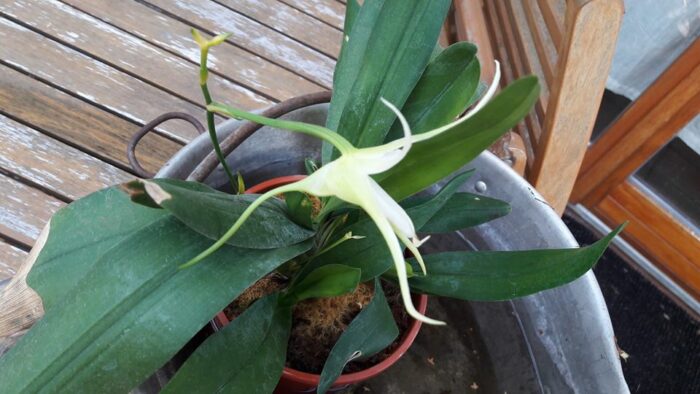Orchids are prized for their beauty and elegance, and the Aeranthes Grandalena is no exception. This stunning orchid boasts delicate, greenish-white flowers that emit a subtle fragrance, making it a popular choice for orchid enthusiasts. However, like most orchids, the Aeranthes Grandalena requires specialized care to ensure that it remains healthy and blooms regularly. In this comprehensive guide, we’ll explore the ins and outs of caring for this captivating orchid, using real-life examples to help you master the art of Aeranthes Grandalena care.
We may earn an affiliate commission for purchases using our links at no added cost to you.

Getting to Know Your Aeranthes Grandalena
Aeranthes Grandalena is a hybrid orchid, resulting from the crossing of Aeranthes ramosa and Aeranthes grandiflora. This plant is an epiphyte, meaning it naturally grows on other plants for support but doesn’t take nutrients from them. In the wild, you’ll find Aeranthes Grandalena growing on trees in Madagascar and surrounding islands.
Growth Habit and Flowering
This orchid has a monopodial growth habit, which means it grows vertically from a single stem. As the plant grows, it produces aerial roots that help it attach to its host tree. The flowers of Aeranthes Grandalena appear on long, thin spikes that can reach up to 30 cm (12 inches) in length. Each spike can produce multiple flowers, which open sequentially, providing a long-lasting display of blooms.
Ideal Growing Conditions
Light
Aeranthes Grandalena prefers bright, indirect light. Too much direct sunlight can cause the leaves to become sunburned and turn yellow, while insufficient light will lead to poor growth and a lack of blooms. Place your orchid in a spot where it receives filtered light through a sheer curtain or under the canopy of taller plants. Remember the story of Jane, who moved her orchid to a south-facing window behind a sheer curtain, and saw a significant improvement in its overall health and flower production.
Temperature
This orchid thrives in intermediate to warm temperatures. Aim to maintain daytime temperatures between 21°C to 29°C (70°F to 85°F) and nighttime temperatures between 15°C to 18°C (60°F to 65°F). Be sure to protect your Aeranthes Grandalena from sudden temperature fluctuations, as these can stress the plant and lead to bud drop.
Humidity
As a tropical plant, Aeranthes Grandalena appreciates high humidity levels. Aim for 60% to 80% humidity in the growing area. You can use a humidifier or place your orchid on a tray filled with water and pebbles, ensuring the pot isn’t sitting in water. Misting the plant’s leaves and aerial roots daily can also help maintain humidity levels.
Air Circulation
Aeranthes Grandalena needs good air circulation to prevent diseases and encourage healthy growth. Make sure there’s a gentle airflow around your plant, either from a nearby open window or a small fan. However, avoid exposing your orchid to cold drafts or direct blasts from heating or cooling systems.
Watering and Feeding
Watering
Aeranthes Grandalena has a unique watering requirement compared to other orchids. It prefers to stay consistently moist but not soggy. Water your orchid thoroughly, allowing water to flow through the potting mix and drain out the bottom. Aim to water your plant every 5 to 7 days, but always check the moisture levels in the potting mix before watering. A useful tip is to insert a wooden skewer or your finger into the mix; if it feels damp, hold off on watering for another day or two. Overwatering can lead to root rot, which can be detrimental to your orchid’s health.
Feeding
To ensure your Aeranthes Grandalena gets the nutrients it needs to grow and bloom, feed it with a balanced, water-soluble orchid fertilizer every two weeks. Follow the manufacturer’s instructions for dilution rates, and be sure to water your plant thoroughly before feeding to prevent fertilizer burn.
Repotting and Potting Mix
When to Repot
Aeranthes Grandalena should be repotted every two years or when the potting mix starts to break down and become too compact. Signs that your orchid needs repotting include yellowing leaves, reduced growth, or roots growing out of the pot.
Potting Mix
The ideal potting mix for Aeranthes Grandalena is a well-draining, airy mix that retains some moisture. A combination of fine bark, sphagnum moss, and perlite works well for this orchid. Make sure to use a mix specifically designed for epiphytic orchids to ensure your plant gets the right balance of air and moisture.
Pruning and Maintenance
Pruning
After your Aeranthes Grandalena has finished blooming, it’s essential to trim the flower spike to encourage new growth and future blooms. Using sterilized pruning shears, cut the spike back to just above the node where the first flower appeared. This will encourage the development of a new flower spike in the coming months.
Pest Control
Keep an eye out for common orchid pests, such as mealybugs, scale insects, and spider mites. Regularly inspect your plant and treat any infestations with insecticidal soap or horticultural oil.
The Secret to a Happy Aeranthes Grandalena
With the right care, your Aeranthes Grandalena will reward you with stunning, fragrant blooms that can last for months. Remember the key aspects of its care: bright, indirect light, warm temperatures, high humidity, consistent moisture, and proper feeding. By providing these optimal conditions and following this comprehensive guide, you’ll be well on your way to nurturing a thriving, blooming beauty.
So go ahead, take the plunge, and add an Aeranthes Grandalena to your orchid collection. This captivating plant is sure to become a cherished addition to your home or greenhouse, bringing joy and delight for years to come.
Here are some Amazon products that would complement Orchid Care:
- Orchid Potting Mix: A high-quality, well-draining potting mix specifically designed for epiphytic orchids, such as Sun Bulb Company Orchid Brown Bark.
- Orchid Fertilizer: A balanced, water-soluble orchid fertilizer to ensure your Aeranthes Grandalena gets the nutrients it needs, like Miracle-Gro Orchid Food Mist.
- Humidity Tray: A tray filled with pebbles and water to help maintain humidity levels around your orchid, such as a Humidity Tray.
- Small Clip-On Fan: To provide the gentle air circulation needed by Aeranthes Grandalena, consider the Genesis 6-Inch Clip-On Fan.
- Humidity Monitor: A digital hygrometer to help you monitor the humidity levels in your orchid’s environment, such as the ThermoPro TP50 Digital Hygrometer.
- Insecticidal Soap or Horticultural Oil: To control common orchid pests, a product like Bonide All Seasons Horticultural Oil can be useful.
These products will help you provide the proper care for your Aeranthes Grandalena orchid, ensuring its health and beautiful blooms.
Frequently Asked Questions About Aeranthes Grandalena
Can I grow my Aeranthes Grandalena outdoors?
Yes, you can grow your Aeranthes Grandalena outdoors, provided that you can maintain the ideal growing conditions. Ensure the plant receives bright, indirect light, and protect it from extreme temperature fluctuations. Additionally, monitor humidity levels and water the plant accordingly. If you live in a region with cold winters, bring your orchid indoors during the colder months to protect it from freezing temperatures.
How can I tell if my Aeranthes Grandalena is receiving enough light?
One way to determine if your Aeranthes Grandalena is receiving sufficient light is to observe the color of its leaves. Healthy leaves should be a vibrant, medium green. If the leaves are dark green, your plant may not be getting enough light, while yellowing leaves could indicate too much direct sunlight. Adjust the plant’s location accordingly to ensure it receives the optimal amount of light.
My Aeranthes Grandalena has stopped blooming. What could be the cause?
Several factors could contribute to your Aeranthes Grandalena not blooming, including insufficient light, improper watering, inadequate fertilization, or an unhealthy root system. Ensure that your orchid is receiving the appropriate care by reviewing the care guide above and making any necessary adjustments. Be patient, as it may take some time for your plant to recover and produce new blooms.
Can I propagate my Aeranthes Grandalena?
Propagating Aeranthes Grandalena can be challenging for novice orchid growers, as it typically involves the process of sowing seeds in a sterile environment. This method requires specialized equipment and expertise. Alternatively, if your plant produces a keiki (a small plantlet that grows from the mother plant), you can carefully remove it once it has developed several roots and pot it separately. However, keikis are not common in Aeranthes Grandalena, so propagation through seeds is the primary method for this orchid.

About Author
Hannah Anderson is a passionate garden enthusiast with over a decade of experience. She has been sharing her knowledge and expertise on this website and her articles and tips have helped countless individuals create beautiful and thriving gardens. Whether you’re a seasoned green thumb or just starting out, Hannah’s practical advice and creative ideas will inspire and guide you on your gardening journey.
